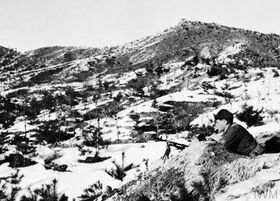Battle of Point 48-100
| Battle of Point 48-100 | |||||||
|---|---|---|---|---|---|---|---|
| Part of the The Northern Corridor Wars | |||||||
 An MG Nest manned by a trooper from the Argyll and Sutherland Highlanders of Rubrum at the Kentii Mountains. | |||||||
| |||||||
| Belligerents | |||||||
| Commanders and leaders | |||||||
| Strength | |||||||
| Approx. 10,000 - 15,000 | 80,000 - 100,000 | ||||||
| Casualties and losses | |||||||
|
2,624 killed or wounded
|
49,921 killed or wounded
| ||||||
The Battle of Point 48-100 (10 December 1946 - 24 December 1946) was an engagement between the besieged Rubrumian and Jutlandish forces around the Kentii Mountains and the attacking Communist Lorican forces. The battle came as a result of Communist intel reporting that Kurosawa and his forces were marching at the Kentii Mountains. The Commissar of the North, Branislav Mukhomorov saw this as an opportunity to capture one of the Allies key leaders in the conflict. The battle is best remembered for General Harry Kurosawa prevailing with meagre numbers against overwhelming enemy forces, which earned him the nickname of The Iron Fox.
In 8 December 1948, Mukhomorov, with the aid of Quenminese General Ong Thao Pin was able to cut off Brigadier General Rang Seong-hun's forces, who were closely following behind Kurosawa. By the following day, Mukhomorov had isolated the Kentii Mountains by means of mass infantry movements around the area. Kurosawa would find himself cut off from any chance of reinforcements. Mukhomorov gave out surrender fillers to Kurosawa, to which he shut down and declared that he will stand his ground. Rather than scattering his forces all over the 200km wide mountain range, Kurosawa placed defenses along a 120km long radius around his position with key defensive nests placed at vital avenues and routes to his position. He placed the responsibility of defending the northern and western flanks to the Jutlanders under Brigadier Allone Grønkjær and the southern and eastern flanks to Brigadier Murasame Susaya.
The attacks started in 10 December. The Communists expected that the Allied defenses would swiftly fall in a single day, launching continuous barrage and tank offensives closely aided by infantry. Much to their surprise, the Rubrumian-Jutlandish troops successfully repulsed the attacks. The Loricans switched their strategy by pushing with full force on two flanks by navigating on the weakest part of the mountains. There were two weakspots near the eastern and southwestern flanks of the summit, which the Loricans successfully pushed into, reaching about 100kms from the main central command. Kurosawa feinted a retreat from the southeastern flank, in which Kurosawa intended to lure the Loricans into a trap by means of a route that could take them straight to his position. Kurosawa positioned his forces well and prepared artillery regiments to prepare barraging the area. Mukhomorov, not realising the trap, chose to attack in the night, hoping to catch Kurosawa off-guard. In 18 December, the Loricans took the retreat and found themselves at the face of an intense Rubrumian and Jutlandish shelling on that night. Mukhomorov had given a no retreat order, hoping to capitalise on the opportunity but when the morning came, he was stunned that not a single of his soldiers had breached the Rubrumians, losing the patch of land that they took just 5 days ago. Mukhomorov would finally carry out a do-or-die charge on all critical positions by 20 December. The poorly coordinated charge proved to be a disaster for the Communists and their Quenminese allies, as the charges had all but been repulsed. By 23 December, the Loricans had all but exhausted their strength. Although they still had more men, Mukhomorov decided that attempting another attack would fail and subsequently retreated south.
For 14 days, the Rubrumians and Jutlandish forces were surrounded on all sides but thanks in part to their flexible planning and fast shift in movements and tactics, they succeeded in repulsing every offensive attack thrown by the Loricans. This became a blow to Marshal Hồ Danh Sĩ Quốc, whom he entrusted the Loricans for the destruction of Kurosawa's forces, as they were forced out of the Kentii Province and retreated westward.